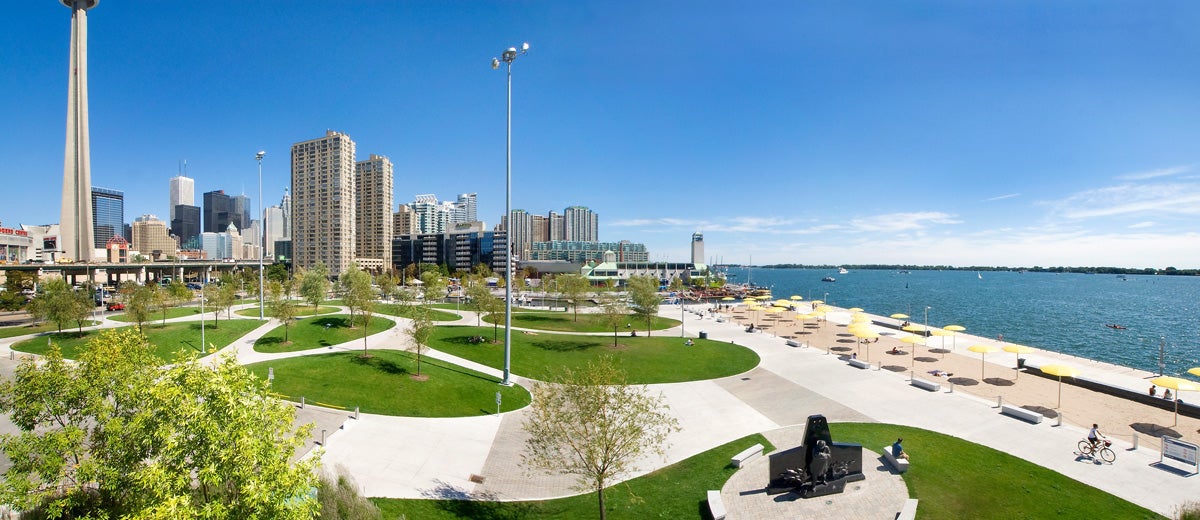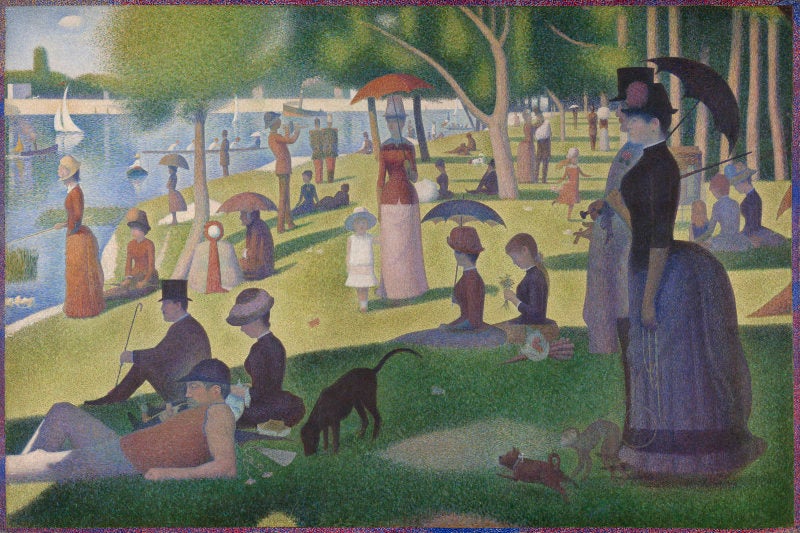Parking It: Discovering HTO Park
Beach goers meld into the central waterfront scene set against the iconic downtown skyline. (Image by @tayhuff13 on Instagram)
Parking It is a weekly series of blog posts – running all summer long – that will explore Toronto’s system of waterfront parks.
The first beach to be built in the central waterfront, HTO Park is definitely entitled to its bragging rights – with a checklist that includes: award-winning, sustainable ecosystem, cultural hub, and recreational destination.
Not too long ago the idea of venturing onto a white sandy beach in downtown Toronto would have seemed rather fantastical. With its lakefront location and tree-dotted plots of green fields, HTO Park is another large public space debunking perceptions of central Toronto as a maze of concrete and steel.
Aspects of HTO Park exemplify the land repurposing and sustainability features that have become essential in contemporary urban design.
HTO Park sits on about 1.8 Hectares (4.3 acres) of former industrial land. Many industrial business vacated the downtown area and migrated in-land when extended highways and roadways ended their dependence on shipping by sea. The result was a stretch of vacant and polluted land along the waterfront that was ready for repurposing. The first step in remediating the HTO Park site was to "cap" or bury the contaminated soil with a thick layer of clean soil, which created a safe new foundation for the park. This formerly closed-off industrial property was then converted into HTO Park, opening new public access to the water's edge where there previously was none. The entrance and pathways within and surrounding the park are multi-use and barrier-free, providing multiple access points into the park along Queens Quay. HTO Park also sits along the Martin Goodman Trail, which connects many parks and public spaces along Toronto’s waterfront.
In addition to improved public access to the lake, new vegetation and built-in structures encourage sustainable biodiversity in HTO Park. On-site debris and concrete were recycled and used to build aquatic habitat and wetland areas. These structures are now home to many species of birds, fish and microorganisms.
Sustainability and re-purposing measures extend to water use at the park. An on-site irrigation system draws from Lake Ontario to water the park’s vegetation.

An aerial view of the barrier-free pathways encircling HTO Park’s grass islands and beach strip. (Image by Neil Fox)
Plots of gently domed green islands are shaded by willow and maple trees. LED lighting illuminates these grassy knolls at night. Interconnected paths encircling the grass mounds allow barrier-free navigation and also regulate storm water flow throughout the park. The paths are made of a porous material and they absorb excess storm water and slope to manage flooding.
HTO Park is an open, people-friendly space that readily lends itself to public art and cultural happenings.
The many places to rest in HTO Park invite you to stay for a while. You can grab a Muskoka chair under the shelter of stationary metal and fiberglass umbrellas. Benches and low ledges run along the beach, while grassy oases welcome solitary and group gatherings.
HTO Park has emerged as a centre for cultural events and small business development, creating the types of economic opportunities that have allowed neighbourhoods to bloom in the areas around the park
A docked ship towers several metres high over onlookers at the Redpath Waterfront Festival this July. (Image by @twigweddings on Instagram)
HTO Park is the venue of several festivals and events throughout the year, including happenings hosted by Harbourfront Centre, Redpath, TIFF (Toronto International Festival) and Luminato. This summer the park hosts an artisan market with wares from over 50 local vendors that offer crafts, experiences and a wide assortments of foods.
Artisans and vendors interact with shoppers perusing market stalls at HTO Park. (Image by BlogTO on Instagram)
The celebration of water is a recurring theme throughout HTO Park and entertainment here is not confined to land. Boating, canoeing and jet skiing are just a few of the many activities that take place on waves just off HTO Park.
Stored canoes form a colourful wall along the water’s edge. (Image by @Johnyaudesign on Instagram)
“HTO” is a nod to the chemical composition of water, H2O, and is symbolic of connectivity between the public and the waterfront.
To understand the name “HTO” you must look to science -- "HTO" is a nod to H20, the chemical composition of water. For an in-depth understanding of HTO Park’s design, we turn to modern art.

The design of HTO Park drew inspiration from Georges Seurat’s Impressionist painting, “A Sunday Afternoon on the Island of La Grande Jatte.” (Image by the Art Institute of Chicago)
In transforming derelict industrial space into HTO Park, designers found inspiration in Georges Seurat’s impressionist painting, “A Sunday Afternoon on the Island of La Grande Jatte” of 1884. Seurat’s artwork depicts figures during a moment of leisure on a grass shore along a waterfront, some holding umbrellas.
The HTO Park revitalization project was a city-led initiative and the design of HTO Park was developed by Janet Rosenberg & Studio, Claude Cormier Associés Inc. and Hariri Pontarini Architects. HTO Park’s multiple awards include: Nature Spaces Award, 47th International Making Cities Livable Honor Award, American Society of Landscape Architects Regional Honour, Canadian Society of Landscape Architects Gold Award, and an award from the Design Exchange.
Quick HTO Park Facts:
• 1.8 hectares (4.3 acres)
• Open-air weekend summer artisan market with 50 stalls
• Barrier-free access to Martin Goodman trail, main downtown core and amenities including:
o Sand beach
o Boardwalk
o Muskoka chairs
o Stationary beach umbrellas
o Outdoor Showers
• Design awards won:
o Nature Spaces Award, 47th International Making Cities Livable
o Honor Award, American Society of Landscape Architects
o Regional Honour, Canadian Society of Landscape Architects
o Gold Award, Design Exchange
